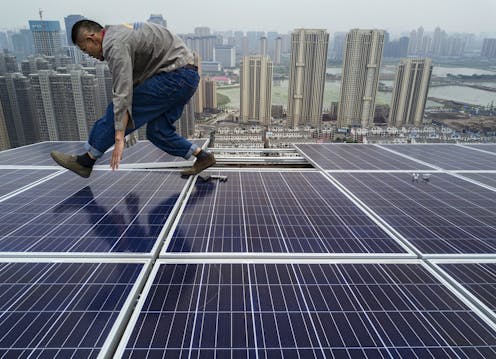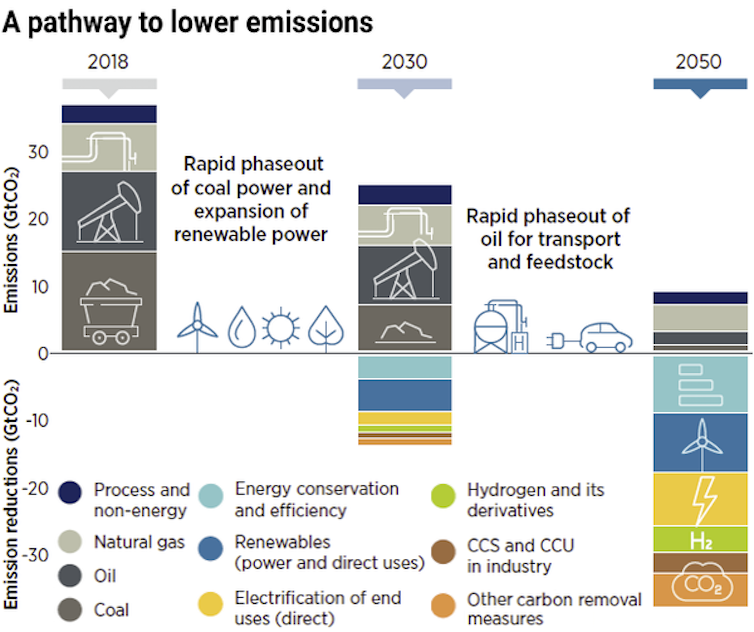4 strategies for a UN breakthrough on energy and climate change
For the first time in 40 years, the UN General Assembly is convening a global summit of world leaders to talk solely about energy.

Two important events hosted by the United Nations are coming up that are widely hoped to help address what the U.N. calls the “dual challenge” – fighting climate change and ensuring that poorer countries can develop sustainably. Energy is a central theme in both.
For the first time in 40 years, the U.N. General Assembly is convening a global summit of world leaders focused solely on energy. If all goes as planned on Sept. 24, 2021, they will consider a road map that includes tripling investment in renewable power and making affordable modern and clean energy available to everyone everywhere within the decade.
The second event is the U.N. climate conference in November, where negotiators representing nations around the world will be asked to ramp up their countries’ efforts to reduce their greenhouse gas emissions.
This year’s climate summit will be the first to assess progress toward meeting the 2015 Paris climate agreement, and there are some remaining sticking points in how nations will meet their promised targets. Resolving these will be important for the credibility of the agreement and the willingness of developing countries to commit to further progress.
As climate policy experts with decades of experience in international energy policy, we have identified four strategic priorities that would help provide the foundations for success in both the energy and climate change domains.
What has been achieved so far?
Despite the ambitious goals in many countries, the world’s greenhouse gas emissions have continued to rise. The year 2020 was a brief exception – emissions fell significantly due to the global pandemic – but that trend has already reversed as economies recover.
The statements released by world leaders after the recent G7 and G20 meetings underlined recognition of the problem. Still, very few countries and companies have detailed plans and budgets in place to meet their own high-level goals.

4 strategic priorities
Getting energy and climate policies worldwide headed in the same direction is a daunting task. Here are four strategies that could help countries navigate this space:
1) Deploy carbon pricing and markets more widely.
Only a few countries, states and regions currently have carbon prices that are high enough to push polluters to cut their carbon dioxide emissions. The climate negotiations in Scotland will focus on getting the rules right for global markets.
Making these markets function well and transparently is essential for effectively meeting the many net zero climate goals that have been announced by countries from Japan and South Korea to the U.S., China and the European Union. These include rules on the use of carbon offsets – they allow individuals or companies to invest in projects that help balance out their own emissions – which are currently highly contentious and largely not functional or transparent.
2) Focus attention on the “hard-to-decarbonize” sectors.
Shipping, road freight and industries like cement and steel are all difficult places for cutting emissions, in part because they don’t yet have tested, affordable replacements for fossil fuels. While there are some innovative ideas, competitiveness concerns – such as companies moving production outside regulated areas to avoid regulations – have been a key barrier to progress.
Europe is trying to overcome this barrier by establishing a carbon border adjustment mechanism, with emission levies on imports similar to those for European producers. The Biden administration is also exploring such rules.
3) Get China and other emerging economies on board.
It is clear that coal, the most carbon-intensive fossil fuel, needs to be phased out fast, and doing so is critical to both the U.N.‘s energy and climate agendas. Given that more than half of global coal is consumed in China, its actions stand out, although other emerging economies such as India, Indonesia and Vietnam are also critical.
This will not be easy. Notably half of the Chinese coal plants are less than a decade old, a fraction of a coal plant’s typical lifespan.
4) Focus on innovation.
Support for innovation has brought us cutting-edge renewable power and electric vehicles much faster than anticipated. More is possible. For example, offshore wind, geothermal, carbon capture and green hydrogen are new developments that can make a big difference in years to come.
Who leads in developing these new technologies, and which companies, will reap important economic benefits. They will also support millions of new jobs and economic growth.
Luckily, investors are actively supporting these technologies. More investors are starting to believe in energy transitions and are putting their money into developing the associated technologies. Still, increased government support for research and development funding can catalyze these efforts.
An opportunity also exists to broaden innovation efforts beyond technology, to a systemic approach that includes dimensions such as market design, social acceptance, equity, regulatory frameworks and business models. Energy systems are deeply interconnected to social issues, so changing them will not be successful if the solutions focus only on technology.
Not one solution
It is likely that U.N. energy and climate deliberations over the coming months will continue to move in fits and starts. The real work needs to take place at a more practical implementation level, such as in states, provinces and municipalities. If there is one thing we have learned, it is that mitigating climate change will be a long slog, not a one-off political announcement or celebrity endorsement. It requires much more than simply repeating platitudes.
Politicians need to show that the many energy transitions emerging are good for economies and communities, and can create long-lasting jobs and tax revenues. While it’s uncontested that the benefits of greenhouse gas mitigation far exceed the cost, it is not always easy to marry this with short-term political cycles.
[The Conversation’s Politics + Society editors pick need-to-know stories. Sign up for Politics Weekly._]
The authors do not work for, consult, own shares in or receive funding from any company or organisation that would benefit from this article, and have disclosed no relevant affiliations beyond their academic appointment.
Read These Next
What’s at stake in Trump’s executive order aiming to curb state-level AI regulation
In the absence of comprehensive federal AI regulation, states have stepped in. The Trump administration,…
Data centers need electricity fast, but utilities need years to build power plants – who should pay?
How many data centers will be built – and how much electricity they’ll need – is uncertain. Being…
Sleep problems and depression can be a vicious cycle, especially during pregnancy − here’s why it’s
Inadequate sleep can have negative downstream effects on everyday cognitive functioning and mental health,…





